Thaıdene Nëné badı xá (Working with Thaıdene Nëné): Thaıdene Nëné Relationship Plan, the management plan for Thaıdene Nëné — Draft
Thaıdene Nëné National Park Reserve
On this page
Glossary Footnote 1
Thaıdene Nëné badı xá uses Dene Yatı (the Dene language used in the Thaidene Nëné area) for places and names. There is variation within, as well as between, languages and dialects used in the area. Different families use different words and/or spellings for things.
This document uses the following Dene Yatı terms, as outlined in Table 1.
| Dene Yatı term / placename | Translation / English placename | Pronunciation Footnote 2 |
|---|---|---|
| Ɂedacho Túe /Kúe | Artillery Lake | eh-dah-cho too-way / eh-dah-cho coo-way |
| Ɂedacho Tł’ázı̨ | Timber Bay | |
| Thaıdene Nëné badı xá | how we will look after Thaidene Nëné (title of the relationship plan) | thigh-den-ay nen-ay bye-dee ha |
| Ɂena Tué | Gagnon Lake | |
| Ɂıdor Bekue Chëlé Tł’ázı̨ | Christie Bay | |
| Bet’sı́ghı́ | Utsingi Point | |
| Dene Yatı | the Dene language used in the Thaidene Nëné area | den-ay yaw-tea |
| Desnéthcheé | Spiritual Gathering Site | dez-net-chay |
| Dzén Kı́n | Muskrat (rat) Lodge (a sacred place on Ɂedacho Tué) | dzen keen |
| Hachoghe’s Shovel | The Giant's shovel | |
| Hakéth Hoɂé or Kaché Kaɂá | the place you go up to the lake (Pike’s Portage) | |
| Kaché Kuwé | McLeod Bay | catch-ay coo-way |
| Keldelé | open shallow water, all year around (Taltheilei Narrows) | |
| Łúh Chogh Tué | Big whitefish lake (Whitefish Lake) | …too-way |
| Ni Hat’ni Dene | watchers of the land (Indigenous guardians) | nee hot-nee den-ay |
| Nuwe néné | our land | new-way nay-nay |
| Nuwé ch’anıe | principle that describes all Dene values and knowledge systems. | new-way ch awe-nee |
| Taché / Kaché | Charlton Bay area | tatch-ay / catch-ay |
| Tesuchai Tu / Kesuchai Kuwe | Siltaza Lake | |
| Thílo dëzé | Thelon River | tea-low deh-zay |
| Tł’ąkĕle | Thompson Landing | |
| Tsąkuı Thedá Dezé | Lockhart River | tsaa-kwee thay-da deh-zay |
| Tsá Kı́n | Beaver Lodge (a sacred place on Ɂedacho Tué) | tsaa keen |
| Tsąkuı Thedá | Parry Falls | tsaa-kwee thay-da |
| Tthe Kálįka Tué | Stark Lake | |
| Tu Nedhé | Great Slave Lake | tsaa-kwee thay-da |
| Thaidene Nëné | Land of the Ancestors | thigh-den-ay nen-ay |
| Thaıdene Nëné Xá Dá Yáłtı Footnote 3 | those who speak for Thaidene Nëné | thigh-den-ay nen-ay ha da yah-tea |
| TBD | Back River |
Terms and meanings
In this document the following terms have certain meanings, as outlined in Table 2.
| Term | Meaning |
|---|---|
| Original Indigenous peoples of the area / the descendants of Thaidene Nëné ancestors | Means the Dene and Métis descendants of Thaidene Nëné ancestors. |
| Shared Operational Management Partners (the Partners) | Means Łutsël K’é Dene First Nation, Northwest Territory Métis Nation, Parks Canada, and Government of Northwest Territories, as applicable. |
| Signatory Indigenous governments | Means Łutsël K’é Dene First Nation, Northwest Territory Métis Nation, Deninu Kųę́ First Nation, Yellowknives Dene First Nation, as applicable, that are signatories to establishment or impact/benefit agreements. |
| Regional Management Board | Has the same meaning as “Regional Management Board” or “Regional Management Body” in the Establishment and Impact Benefit Agreements Footnote 4 for Thaidene Nëné. |
| Thaıdene Nëné Xá Dá Yáłtı | Has the same meaning as “Thaıdene Nëné Xá Dá Yáłtı” or “Thaidene Nëné Management Board” in the Establishment and Impact Benefit Agreements Footnote 5 for Thaidene Nëné. |
Introduction
Thaidene Nëné Indigenous Protected Area (Thaidene Nëné) is located within the territories of the Akaitcho Dene First Nations and the Northwest Territory Métis Nation in the Northwest Territories, Canada (see Figure 1).
Figure 1 – Where is Thaidene Nëné Indigenous Protected Area

Figure 1 – Where is Thaidene Nëné Indigenous Protected Area — Text version
On the top right corner, an inset map locates Thaidene Nëné Indigenous Protected Area and the Northwest Territories within Canada. The larger map locates Thaidene Nëné within the Northwest Territories. On the large map, Thaidene Nëné is located near the community of Łutsël K’é, on the east shore of Tu Nedhé (Great Slave Lake). It stretches from the East Arm of Tu Nedhé (Great Slave Lake) to the tundra.
Thaidene Nëné, which means “Land of the Ancestors”, has sustained the Indigenous peoples from time immemorial. Thaidene Nëné is a largely pristine and healthy landscape and is the result of countless generations who have cared for the land and water. Nuwé ch’anıe, the principle that describes all values and knowledge systems of the original Indigenous peoples of the area, is inherently connected to the land and is vital to the ongoing stewardship of Thaidene Nëné.
Protected areas such as Thaidene Nëné are often guided by management plans. These plans set out a long-term vision, specific objectives, and provide strategic direction. However, the term ‘management’ implies control and ownership over the land, as well as a level of separation between land and people that does not exist within Indigenous worldviews. We have chosen to name this management plan a relationship plan. This designation highlights the importance of the relationships between the descendants of Thaidene Nëné ancestors, the land, water, and animals.
Thaıdene Nëné badı xá is built on the foundation of nuwé ch’anıe that has conserved Thaidene Nëné for millennia. The plan draws on the strength of nuwé ch’anıe and provides direction on how we will continue to steward Thaidene Nëné for generations to come.
How does this plan support people?
For Indigenous peoples whose territory includes Thaidene Nëné:
Thaıdene Nëné badı xá ensures and respects the practice of Aboriginal and treaty rights. Indigenous laws and traditions are the foundation for looking after Thaidene Nëné. This plan ensures that the relationship between people and land, and nuwé ch’anıe continues.
For Indigenous business owners from signatory Indigenous governments:
Thaıdene Nëné badı xá helps support Indigenous economic development for members.
For tourism licence holders and people who hold leases in Thaidene Nëné:
Thaıdene Nëné badı xá ensures the ecological integrity and cultural continuity of Thaidene Nëné remain strong, while continuing to welcome visitors.
For visitors to Thaidene Nëné:
Thaıdene Nëné badı xá helps define what a respectful and positive visitor relationship with this land looks like, sets out what activities can happen where, and the importance of story that visitors will learn from Thaidene Nëné and nuwé ch’anıe.
For those that never come here:
Thaıdene Nëné badı xá is assurance that this spectacular place is being well cared for. Things that the public may associate with northern Canada - like caribou and muskox, tundra, clean water, adventure, beauty, vibrant Indigenous cultures, and vast and wild spaces - will continue to exist because of what is being done to ensure healthy and respectful relationships with Thaidene Nëné.
Background
In Thaidene Nëné, there is a living connection between the land, the water, the plants, animals, and people. Indigenous ways of life are practiced, nurtured, and passed on to future generations.
Thaidene Nëné is the heart of the Łutsël K’é Dene homeland, where many generations ago, the ancestors established the foundations for the Dene way of life, a way of life that continues to be practiced today. At the centre of Thaidene Nëné is Tsąkuı Thedá. It is the most important cultural and sacred place in Thaidene Nëné for the original Indigenous peoples of the area.
Thaidene Nëné is a rich cultural landscape that includes many ancient trails, camps, and village sites. There are numerous places of spiritual and cultural importance to the descendants of Thaidene Nëné ancestors, as represented by Łutsël K’é Dene First Nation, Deninu Kųę́ First Nation, Yellowknives Dene First Nation, and the Northwest Territory Métis Nation (referred to as “signatory Indigenous governments” in the plan).
The spectacular landscape of Thaidene Nene has been shaped by glaciers Footnote 6 that have helped form the stunning vertical cliffs, canyons, islands, peninsulas, and waterfalls surrounding Tu Nedhé. Within Tu Nedhé, Ɂıdor Bekue Chëlé Tł’ázı̨ boasts the deepest water in North America, and the pristine waters make for excellent habitat for Lake Trout, Lake Whitefish, Arctic Grayling, Cisco, and many other species. Tu Nedhé is surrounded by boreal forest, which transitions to lichen woodland and on to tundra, as you move northeast. The tundra has giant eskers, important habitat for wildlife, that meander across the landscape.
Many northern species rely on vast, intact areas to thrive, and the forest and tundra landscapes of Thaidene Nëné are an important component of their range. This is a landscape that both Arctic and Boreal species use, such as Barren-ground caribou, muskox, wolverine, grizzly bear, wolf, moose, lynx, and black bear. Important waterfowl staging and bird nesting areas are also found throughout Thaidene Nëné.
What types of protected areas are included in Thaidene Nëné?
Thaidene Nëné Indigenous Protected Area is 26,376 km2 in size. Thaidene Nëné was established using Dene law, Agreements with the signatory Indigenous governments, the Canada National Parks Act, and the Northwest Territories’ Protected Areas Act and Wildlife Act. Thaidene Nëné is made up of several parts—a national park reserve, a territorial protected area, and a territorial wildlife conservation area (see Figure 2 Footnote 7).
The core of Thaidene Nëné is protected as a national park reserve, through the Canada National Parks Act. National parks are established to protect and present outstanding representative examples of natural landscapes that occur in each of Canada's 39 unique natural regions. Thaidene Nëné is considered an outstanding example of the Northwestern Boreal Uplands Natural Region. National parks promote understanding, appreciation and enjoyment in a way that maintains their ecological integrity. In establishing Thaidene Nene National Park Reserve, Parks Canada has also committed to the continuation of Indigenous ways of life.
Figure 2 – Thaidene Nëné Indigenous Protected Area

Figure 2 – Thaidene Nëné Indigenous Protected Area — Text version
On the top left corner, an inset map locates Thaidene Nëné Indigenous Protected Area within the southwest area of the Northwest Territories. The larger map shows the three component parts on Thaidene Nëné in different colors. The largest part is the National Park Reserve in green. The Territorial Protected Area is shown in purple and is divided into three pieces, all adjacent to the National Park Reserve. In the northeast is a Wildlife Conservation Area in yellow.
Other parts of Thaidene Nëné are protected as a territorial protected area through the Northwest Territories’ Protected Areas Act. Thaidene Nëné Territorial Protected Area is established and cared for collaboratively by the Government of Northwest Territories, Indigenous governments, and Indigenous organizations to protect the biodiversity, ecological integrity, and cultural continuity of the Northwest Territories.
The most northerly portion of Thaidene Nëné is designated as a Wildlife Conservation Area under the Northwest Territories Wildlife Act. The area is currently protected from development through a Land Withdrawal Order under the Northwest Territories Lands Act. The Land Withdrawal Order will remain until supplemental mechanisms, such as an approved land use plan for the area, are in place. Thaıdene Nëné badı xá doesn’t apply to the Wildlife Conservation Area, which is managed in accordance with the Wildlife Act.
Fort Reliance National Historic Site is located within Thaidene Nëné National Park Reserve near Desnéthcheé (the spiritual gathering site for Łutsël K’é Dene First Nation) in the area known as Taché/Kaché. The site features four stone fireplaces and chimneys that are considered unique relics of the history of the exploration and commerce in Canada's North. Designated in 1953, without the consultation or participation of the original Indigenous peoples of the area, the National Historic Site commemorates Captain George Back's travels along the Thílo dëzé and Great Fish (now Back) River in the 1830s.
Who makes decisions about and takes care of Thaidene Nëné?
Making operational decisions about and taking care of Thaidene Nëné, is the shared responsibility of the Partners, being the Łutsël K’é Dene First Nation, Northwest Territory Métis Nation, Parks Canada, and Government of Northwest Territories. Deninu Kųę́ First Nation and Yellowknives Dene First Nation Footnote 8, through their establishment agreements, also play a key role in providing guidance for stewardship of Thaidene Nëné. The four Indigenous governments that signed agreements (referred to as “signatory Indigenous governments”), have different responsibilities and roles on two boards: Thaıdene Nëné Xá Dá Yáłtı and the Regional Management Board.
The Partners are ultimately responsible for operational matters within Thaidene Nëné, with operational decisions under the guidance of Thaidene Nëné Xá Dá Yáłtı, which means “those who speak for Thaidene Nëné” being the starting point. Thaidene Nëné Xá Dá Yáłtı provides decisions, which are referrals, to the Łutsël K’é Dene First Nation, Northwest Territory Métis Nation, Parks Canada, and Government of Northwest Territories. Tasked with thinking long term for the land and the people, Thaidene Nëné Xá Dá Yáłtı provides direction on planning, operations, monitoring, and evaluation within Thaidene Nëné. Thaıdene Nëné Xá Dá Yáłtı uses consensus to make decisions. These decisions guide how operations are carried out to protect ecological integrity and Indigenous ways of life and ensure future generations can live in relation to the land as the ancestors did. Members of Thaidene Nëné Xá Dá Yáłtı are appointed by the Partners. Members do not represent the Partner that appointed them; they speak for Thaidene Nëné.
The Regional Management Board provides recommendations and guidance to Thaidene Nëné Xá Dá Yáłtı and provides recommendations to Łutsël K’é Dene First Nation, Government of Northwest Territories, and Parks Canada. Recommendations are made by consensus. Members are appointed by, as applicable, the three Akaitcho Dene First Nations (Łutsël K’é Dene First Nation, Yellowknives Dene First Nation, and Deninu Kųę́ First Nation), Government of Northwest Territories, and Parks Canada. Unlike the members who sit on Thaidene Nëné Xá Dá Yáłtı, members of the Regional Management Board are representatives of the governments that appoint them.
Planning context
Thaıdene Nëné badı xá is the first plan for Thaidene Nëné. Much of the work for this first plan is foundational, setting out what is needed to ensure that countless generations to come will be able to care for and benefit from Thaidene Nëné. The plan is for ten years (2024-2034), and includes a set of guiding principles, a long-term vision for Thaidene Nëné; and a series of goals, objectives, and targets/indicators that will help us make progress towards achieving the plan’s vision.
What hide tanning can teach us about management planning
Throughout the process of developing Thaıdene Nëné badı xá, Thaidene Nëné Xá Dá Yáłtı took inspiration from the practice of hide tanning, which is integral to Indigenous communities with connections to Thaidene Nëné Footnote 9. Hide tanning offers an appropriate cultural metaphor to demonstrate the steps of management planning (see Figure 3, Hide tanning as management planning, and Table 1).
Figure 3 — Hide tanning as management planning
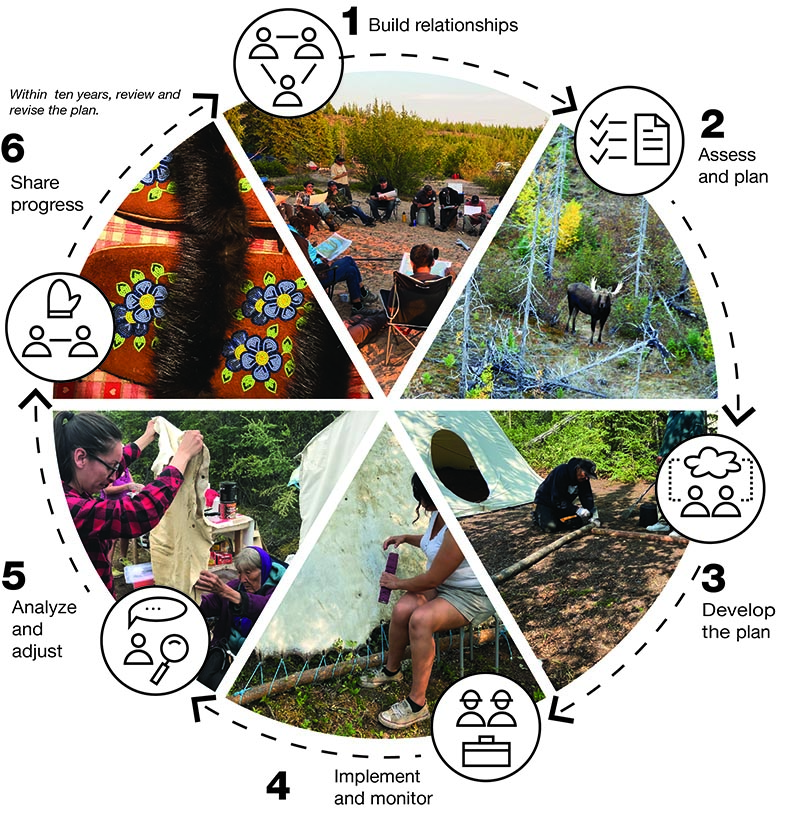
Figure 3 — Hide tanning as management planning — Text version
The image illustrates the hide tanning process and the corresponding planning steps. A circle is divided into 6 equal slices showing a picture of a hide tanning step in each slice, with an icon on the outside of the circle depicting the associated planning step. The first step (build relationship) is at 12 o’clock and shows people sitting in a sharing circle, each looking at a map in their hands. The associated icon shows collaboration between 3 people. The second step (assess and plan) is at 2 o’clock and shows a moose. The icon shows a check list beside a document. The third step (develop the plan) is a 4 o’clock and shows a man building a wood frame on the ground. The icon shows two persons with a dotted line from their head to a cloud. The fourth step (implement and monitor) is at 6 o’clock and shows a woman tanning a hide stretched on a wooden frame. The icon shows two people with working hats and a toolbox. The fifth step (analyze and adjust) is at 8 o’clock and shows a young woman holding a hide while an Elder woman is inspecting the hide. The icon is showing a person, magnifying glasses and a speech bubble. The six step (share the progress) is at 10 o’clock and shows a pair of beaded mittens with fur. The icon shows two people exchanging a mitt. On the outside of the circle, there is a dotted arrow in clockwise direction between each icon. There is a note in the top left corner of the illustration saying “Within 10 years, review and revise the plan”.
| Management planning process | Hide tanning process |
|---|---|
|
Establish effective connections with communities, stakeholders, local leadership to ensure a broad range of views are represented. |
|
Determine scope. Follow a critical path Footnote 10 using appropriate steps and methods. Work with the right people. Identify strengths, weaknesses, opportunities, and threats. Determine what we need to address. |
|
Identify guiding principles. Develop a vision, along with goals, objectives, and indicators. Identify annual workplans to achieve objectives and targets. |
|
Implement, and monitor progress through each reporting period of the plan. Each step should build on previous successes and lead toward the overall vision. |
|
Analyze progress and adjust where necessary. Speak with local people, knowledge holders and other experts to assess the effectiveness of the plan in achieving goals. |
|
Share our progress with local communities, leadership, stakeholders, and those to whom we are accountable annually. Within a ten-year cycle, review and revise the plan. |
How did Thaıdene Nëné Xá Dá Yáłtı involve others Footnote 11?
Thaıdene Nëné badı xá will be further shaped by feedback received through community and public engagement, as outlined in the Thaıdene Nëné Xá Dá Yáłtı’s Engagement Strategy Footnote 12.
Guiding principles Footnote 13
Nuwé ch’anıe is the principle that describes Dene values and knowledge systems, with responsibilities to care for the land, water and wildlife. Nuwé ch’anıe encompasses cultural, linguistic, political, and ecological understandings of the relationship the original Indigenous peoples of the area have with Thaidene Nëné. Ensuring nuwé ch’anıe is practiced, nurtured, and passed on is vital for the well-being of people, and ensuring cultural continuity.
Flowing from nuwé ch’anıe, are six additional principles that will guide the work, and ensure it is being done in the right way and with respect. Each are important for good relationships and planning.
| Term | Meaning |
|---|---|
| Insert Dene Yatı term (economic reconciliation) | Supporting Indigenous economic development |
| Insert Dene Yatı term (consensus) | We talk it out |
| Nuwé yakı begháre ɂeghádalıdá (accountability) | We work with our laws |
| Insert Dene Yatı term (collaboration) | Together we are stronger, making room for more than one way of knowing, being and doing |
| Nuwé ch'anıé beréld ı̨ xá ɂą (cultural continuity) Footnote 15 | We will pass on our knowledge and value systems |
| Yúnethé xá (for future generations) | For the future |
Vision statement
Thaidene Nëné is the homeland of the people whose ancestors laid down the sacred, ethical, and practical foundations of their way of life. This land has nurtured and inspired countless generations whose prosperity continues to be ensured by a deep intimacy between the people and the land. For the wellbeing of future generations, this way of life needs to be exercised, nurtured, and passed on.
The living connection between land and people, between water and land, between forest and tundra makes Thaidene Nëné a national treasure. Carrying these connections into the future, the ecological integrity and the Indigenous ways of life of Thaidene Nëné will be a living legacy for all, where we will welcome the world Footnote 16.
Goals, objectives, targets/indicators
Thaıdene Nëné badı xá contains five goals, including:
- Goal 1 — Promote nuwé ch’anıe
- Goal 2 — Sustain the ecological integrity of Thaidene Nëné
- Goal 3 — Maintain healthy relationships
- Goal 4 — Create good visitor knowledge and experience
- Goal 5 — Support opportunities that strengthen Indigenous prosperity and well-being
Each goal focuses on several objectives and identifies targets/indicators for the Partners to implement over the next 10 years Footnote 17. Each Partner has different responsibilities for implementation as outlined in their agreements Footnote 18. Annual workplans will be developed by the Partners, in collaboration with Thaidene Nëné Xá Dá Yáłtı.
Monitoring commitments are woven through many of the goal areas. Combined, they create a comprehensive system that addresses the ecological and cultural continuity components that we are seeking to sustain, support and promote in Thaidene Nëné.
Goal 1 – Promote nuwé ch’anıe
Ensuring nuwé ch’anıe is practiced, nurtured, and passed on is vital for the wellbeing of people and the land. Nuwé ch’anıe is strong. However, as Elders pass on, their knowledge of language and culture is at risk. Sacred places within Thaidene Nëné must be protected, and the stories that are told about them must be shared; Aboriginal and treaty rights must be upheld; Dene Yatı must be protected and revitalized; and youth must be mentored.
Objective 1.1
The descendants of the Thaidene Nëné ancestors maintain their relationship with Thaidene Nëné and cultural continuity is preserved.
Targets/indicators
- Harvesting within Thaidene Nëné by the original Indigenous peoples of the area is encouraged.
- Indigenous governments apply their own protocols for their members’ use of Thaidene Nëné.
Objective 1.2
Thaıdene Nëné Xá Dá Yáłtı uses Dene Yatı in governance, planning, and community engagements.
Targets/indicators
- Thaıdene Nëné Xá Dá Yáłtı meetings, workshops, community engagement sessions, documents, presentations, advertisements, and other communications include Indigenous languages.
- Indigenous placenames are used in Thaidene Nëné documents, maps, reports, presentations, brochures, videos, etc.
Objective 1.3
Young people are learning nuwé ch’anıe from the Elders.
Targets/indicators
- Land-based Elder and youth programming is delivered in Thaidene Nëné. These programs include sharing language, traditional knowledge, spiritual connections to the land, and Indigenous laws and stories of Thaidene Nëné.
Objective 1.4
Knowledge of cultural resources is recorded to share with future generations.
Targets/indicators
- Important cultural resources are identified, and their condition is documented.
Goal 2 – Sustain the ecological integrity of Thaidene Nëné
Together, the water, soil, rocks, plants, animals, migrations, wildfires, freezing, thawing, and all other parts and processes in the ecosystems of Thaidene Nëné have created a landscape that, for countless generations, has supported nuwé ch’anıe. If Thaidene Nëné remains healthy, it will continue to offer this prosperity. However, Thaidene Nëné cannot speak for itself. We have a responsibility to pay attention to what is happening on the land and to take action to protect it.
Wildfires, extreme weather, and other climate induced impacts have not been experienced before at this magnitude. Climate change creates a significant unknown with factors that are less predictable and more severe. Changing snow and ice patterns, shifting wildlife populations and habitats, increase in invasive species, increased intensity of wildfires, and a changing landscape due to permafrost thaw are just a few examples of observed differences. These rapid changes and industrial development adjacent to Thaidene Nëné are placing increased pressure on wildlife and their habitats.
Along with the uncertainty of the future, the current baseline condition of Thaidene Nëné is not fully understood. Monitoring the state of Thaidene Nëné’s ecological integrity is important to help respond to changes in the landscape.
Increased use of Thaidene Nëné by visitors may also have the potential to negatively impact species and their habitat. Waste left on the land from historical use must also be addressed to ensure healthy lands.
Objective 2.1
All habitats and species are sustained.
Targets/indicators
- Climate change trends, projections, and likely impacts on the biodiversity of Thaidene Nëné are identified and tracked over time, including identifying species presence and distribution. Observations of change are informed by Indigenous knowledge.
- Key habitat within Thaidene Nëné is mapped to support good decision-making.
- The Łutsël K’é Dene Caribou Stewardship Plan (Yunethe Xa Ɂetthen Hadı) is followed by the nation’s members. Other Indigenous governments use comparable tools as appropriate to support the conservation of caribou.
- Fire management planning considers climate change impacts, the protection of the community of Łutsël K’é, critical habitat, species at risk, and other key species such as caribou.
- An integrated research and monitoring program is developed collaboratively. It identifies knowledge gaps and includes research priorities.
- Climate adaptation strategies are guided by immediate impacts and results from research and monitoring programs.
- A water resource protection strategy is developed. It includes visitor/community education and invasive species measures.
- A visitor use management policy upholds ecological integrity goals.
- Harvester education supports the ongoing conservation of key habitats and species in Thaidene Nëné.
- Increased understanding of the carbon balance in Thaidene Nëné and high biodiversity areas is built, including how these areas might be impacted by climate change.
Objective 2.2
Guardians are observing the land and supporting conservation objectives.
Targets/indicators
- An Indigenous guardian program expansion strategy is developed.
Objective 2.3
Historic waste left on the land is addressed, and garbage is cleaned-up.
Targets/indicators
- An assessment of waste sites is conducted to identify locations, and a clean-up plan is developed which includes setting standards and prioritizing sites.
- A “pack it in, pack it out” policy is followed by all users of Thaidene Nëné.
Goal 3 – Maintaining healthy relationships
Relationships in Thaidene Nëné – within and between Thaidene Nëné Xá Dá Yáłtı, the Partners and other signatory Indigenous governments – are complex and, in the past, have often been challenging. Today, these relationships are evolving and at different stages. Thaidene Nëné is being implemented in a time of reconciliation. There is a shared understanding that Thaidene Nëné is going to be different.
Thaidene Nëné Xá Dá Yáłtı has made great progress since its formation in 2021. Positive relationships have been formed, building upon the foundations set out in in the agreements. Thaidene Nëné Xá Dá Yáłtı has formalized its operational procedures and has been successful in meeting its work planning targets and indicators.
The approach to shared management makes room for multiple ways of knowing, being, and doing. It allows for new and innovative forms of collaboration, where everyone has a role in achieving shared outcomes. It requires a commitment to ongoing dialogue, consensus building and a willingness to learn and implement.
Objective 3.1
Thaıdene Nëné Xá Dá Yáłtı’s decision making is respectful and honours multiple ways of knowing.
Targets/indicators
- Thaıdene Nëné Xá Dá Yáłtı’s operating procedures and processes welcome different knowledges and approaches, create space for reflection and opportunities to make changes, and strengthen the use of Dene Yatı.
Objective 3.2
The Partners have healthy relationships with each other and work together on implementation.
Targets/indicators
- Joint policy, planning, and communications systems are in place that all Partners have had a voice in developing.
- Operations are collaborative, and human and financial resources are effectively used.
Goal 4 – Create good visitor knowledge and experience
The ancestors walked the trails that their descendants now share with visitors. Sharing Thaidene Nëné means offering meaningful and authentic experiences for visitors, while also contributing to the vitality of ongoing local Indigenous use. The descendants of the ancestors have knowledge and stories to share with visitors that will enrich their experience when they come to Thaidene Nëné.
It is important that visitor experiences have a cultural connection to the ancestors’ stories, and that these stories are conveyed in a culturally appropriate and authentic way. It is also important that we work to tell the whole story of Thaidene Nëné, to shine light on the existence and resilience of the ancestors. As Thaidene Nëné employees and tour operators share this knowledge with visitors, visitors will gain increased reverence for the land, and will tread lightly and with respect. The stories of Thaidene Nëné also reach beyond those who can visit, to all Canadians and to the world.
Thaidene Nëné is just beginning to welcome the world. Developing the infrastructure, protocols and activities that contribute to meaningful experiences for visitors will take time. Understanding who will come to Thaidene Nëné and why, and what their impact will be, will help guide this work and ensure that visitation is sustainable. It will also be important for Thaidene Nëné staff to promote practices for all users that keep the land and water clean and ensure sites are respected.
Objective 4.1
Thaidene Nëné has a diverse visitor offer that provides opportunities to understand and appreciate local Indigenous cultures, histories and values in an accessible, inclusive, and meaningful way.
Targets/indicators
- A tourism strategy is developed that identifies target markets and prescribes authentic, cultural experiences that connect visitors to the land, people and way of life. Product development for visitor markets is harmonized with the use and enjoyment of Thaidene Nëné by local Indigenous people.
- Signatory Indigenous governments are engaged to create a Commemorative Integrity Statement (CIS) for Fort Reliance National Historic Site and revise the Historic Sites and Monuments Board commemoration to reflect the heritage values of the site more accurately.
- A heritage recording and a condition assessment are completed for Fort Reliance National Historic Site.
Objective 4.2
Visitors are welcomed, learn how to respect places of cultural and spiritual importance, and are informed of culturally appropriate behaviours if visiting important sites to ensure visitation is sustainable.
Targets/indicators
- A visitor orientation program is developed. It includes allowable uses of Thaidene Nëné and a visitor code of conduct.
- Visitors receive orientation programming and robust trip planning materials.
- Guardians, staff, and tourism operators working in Thaidene Nëné are trained and supported to welcome visitors and provide them with authentic experiences.
- Visitor access to and behavior at important sites is managed through appropriate tools such as zoning and regulations.
- Zoning and closures are communicated to visitors and enforced.
- A site-specific plan is developed for the Taché/Kaché region, which includes guidelines for visitation.
Objective 4.3
Indigenous cultural activities and languages are central to visitor experiences, products, and promotion.
Targets/indicators
- Interpretive programs are developed based on Indigenous cultures and ways of life and include Indigenous languages.
- Thaidene Nëné products, promotions, advertisements, and visitor orientations include Indigenous cultures, ways of life, and languages.
- Public appreciation for Thaidene Nëné is fostered through promotion and storytelling, even for those who may never visit.
Goal 5 – Support opportunities that strengthen Indigenous prosperity and well-being
Thaidene Nëné has created prosperity for countless generations of Indigenous peoples. Over the past 150 years, the western economy has created new industries and sources of wealth, but Indigenous peoples of the area have been excluded from those benefits. As a protected area, Thaidene Nëné offers a new economy with a host of opportunities. A key priority is the prosperity of members of signatory Indigenous governments.
The establishment and impact and benefit agreements prioritize training and employment for members of signatory Indigenous governments, as applicable. The jobs and business opportunities available to members are focused on the conservation and tourism economy, including jobs with the Partners, as well as business opportunities including guiding, outfitting, catering, and hospitality Footnote 19.
There have been positive employment gains made since Thaidene Nëné was established in 2019, including multiple jobs created in protected area operations, and a few local business operators now provide licensed tourism services to visitors.
Future policy will aim to reduce barriers to employment for members of signatory Indigenous governments, and support Indigenous businesses, while maintaining the cultural continuity and ecological integrity of Thaidene Nëné, promoting consistency and fairness, and ensuring safe and quality visitor experiences.
Objective 5.1
Business opportunities are created that support Thaidene Nëné and benefit signatory Indigenous governments and their members.
Targets/indicators
- A commercial activity licensing policy and land occupancy policy are developed. These policies promote Indigenous businesses operating in Thaidene Nëné.
- Non-Indigenous applicants for business licences in the National Park Reserve demonstrate how their proposed activities will support and benefit Indigenous communities.
- Business opportunities within the Territorial Protected Area look to support and benefit Indigenous communities where possible (e.g., partnerships, employment, building relationships).
Objective 5.2
Maximize employment opportunities of members from signatory Indigenous governments for all positions within Thaidene Nëné.
Targets/indicators
- Human resource/hiring policies support Indigenous applicants applying for and being successful in attaining and retaining Thaidene Nëné jobs.
- A Thaidene Nëné mentorship/leader-in-training program is developed.
Objective 5.3
Infrastructure barriers to local employment are reduced.
Targets/indicators
- Housing units Footnote 20 are available to support staffing of Thaidene Nëné operational positions in Łutsël K’é.
- An office complex and visitor centre is developed in Łutsël K’é, where staff from Łutsël K’é Dene First Nation, Parks Canada, and Government of Northwest Territories can work together collaboratively.
Objective 5.4
Members from signatory Indigenous governments, including youth, have training and education opportunities related to Thaidene Nëné.
Targets/indicators
- Business development, tourism planning, monitoring, and other training opportunities are provided.
- K-12 students learn about Thaidene Nëné through educational programming.
- Scholarship opportunities are available for members of Partner Indigenous governments.
Zoning for visitor activities
Zoning framework
Zoning is an important tool for encouraging good relationships with the land, ensuring visitors are directed to appropriate areas, and sensitive ecological or cultural areas are protected. Zoning does not impact Aboriginal or treaty rights.
The zoning system for Thaidene Nëné is adapted from the Parks Canada system allowing for a unified approach for all protected areas within Thaidene Nëné Footnote 21. Cultural continuity and Indigenous ways of life are foundational to Thaidene Nëné agreements, and the Government of Northwest Territories’ Protected Areas Act; as such, they are incorporated into the zoning descriptions.
Zoning maps for Thaidene Nëné can be found in Appendix A.
Zone I
Areas within Thaidene Nëné that contain unique, threatened, or endangered natural or cultural features. Preservation is the key consideration. Visitor access is not permitted in some Zone I’s, while in others, visitor access is permitted with restrictions.
Zone II
Extensive areas within Thaidene Nëné where ecosystem processes and Indigenous ways of life continue. Visitors have opportunities to experience the living landscape in remote areas with few to no services or facilities.
Motorized access is not permitted with two exceptions Footnote 22:
- visitors may access Zone II via air charter or private aircraft landing Footnote 23 on waterbodies
- visitors may access Zone II by over snow vehicle (e.g., snowmobile)
Zone III
Areas within Thaidene Nëné that support cultural continuity and are managed as natural environments. Visitors have opportunities to experience nature and culture through outdoor recreation activities requiring minimal services or facilities of a rustic nature. There may be commercial leases in this zone.
Motorized access is allowed Footnote 24. Visitors may access any Zone II shoreline adjacent to Zone III waters by motorized boat.
Temporal closures
Temporal closures are tools to restrict visitor access to certain areas or activities for a specific period. These closures relate to various management needs, such as public safety, environmental protection, wildlife conservation, and/or to help facilitate harvesting activities for Indigenous peoples of the area. As there are different legislative regimes for the National Park Reserve and the Territorial Protected Area, the mechanism to apply temporal closures differs.
Parks Canada can create temporary closures, such as a seasonal closure, through two methods:
- a temporal zone identified in the management plan
- by using Superintendent’s Orders from the National Parks General Regulations to close an area or restrict specific activities
The Government of Northwest Territories can create temporary zones in the Territorial Protected Area, when required, by issuing a public notice of the zone at least 30 days in advance and posting a description and map of the zone on the Protected Areas Registry.
Zoning for Thaidene Nëné — Zone I locations
No visitor access
Desnéthcheé (Spiritual Gathering Site)
The community of Łutsël K’é spends time at Desnéthcheé for a spiritual gathering every summer. There is personal and community infrastructure at the site, including a church and arbour. The gathering site of Desnéthcheé is a culturally important area closed to visitors. Invited guests of the Łutsël K’é Dene First Nation are allowed.
Dzén Kı́n (Rat Lodge) and Tsá Kı́n (Beaver Lodge)
Dzén Kı́n and Tsá Kı́n are sacred places on Ɂedacho Tué (Artillery Lake) that are closed to visitor access. Interpretation about their importance will be provided.
Island in Ɂedacho Tł’ázı̨ (Timber Bay)
Gahdële, a powerful medicine man, is buried on this island in Ɂedacho Tł’ázı̨ on Ɂedacho Tué. Visitor access is not allowed.
Restricted visitor access – Guided/accompanied only
Taché /Kaché Village Site
Taché/Kaché is located at the mouth of Tsąkuı Thedá Dezé (Lockhart River). Visitors must be accompanied by Ni Hat’ni Dene, Parks Canada staff, or a licensed guide from a signatory Indigenous government.
Ɂedacho Tł’ázı̨ (Timber Bay) Village Site
This former village is very close to Ɂedacho Tué (Artillery Lake). The site is also near to a Ni Hat’ni Dene operational cabin that is located at Ɂedacho Tł’ázı̨. Visitors must be accompanied by Ni Hat’ni Dene, Parks Canada staff, or a licensed guide from a signatory Indigenous government.
Tsąkuı Thedá Dezé (Lockhart River)
Tsąkuı Thedá Dezé is sacred and includes Tsąkuı Thedá (Parry Falls). The Zone I area extends from the south end of Ɂedacho Tué (Artillery Lake) to the mouth of the river, including the islands located there. Sacred sites must be respected. They are not to be played with, or they lose their power. Unless otherwise noted, when visiting Tsąkuı Thedá Dezé Zone I, visitors must be accompanied by Thaidene Nëné, Ni Hat’ni Dene, Parks Canada staff, or a licensed guide from a signatory Indigenous government. Licensed guides from a signatory Indigenous government may use motorized boats for tours at the mouth of Tsąkuı Thedá Dezé (Lockhart River).
Tsąkuı Thedá Dezé Zone I includes areas where visitor access is further restricted:
- Tsąkuı Thedá Dezé — access prohibited in the river corridor
- Tsąkuı Thedá (Parry Falls) — permission required from Łutsël K’é Dene First Nation
Zoning for Thaidene Nëné — Zone II locations
All areas of Thaidene Nëné not otherwise identified as a Zone I or Zone III are Zone II. This is the majority (78%), which is 92% in the National Park Reserve and 57% in the Territorial Protected Area . Footnote 25 Designation of wilderness in the National Park Reserve through the National Parks of Canada Wilderness Area Declaration Regulations will not be pursued at this time.
Zoning for Thaidene Nëné — Zone III locations
Tu Nedhé (Great Slave Lake)
The waters of Tu Nedhé serve as the front country of Thaidene Nëné, with motorized boating a key form of access and recreation.
Tthe Kálįka Tué (Stark Lake)
Tthe Kálįka Tué waters in the National Park Reserve are Zone III to allow for the continuation of motorized boating.
Waterbodies in the Territorial Protected Area
All waterbodies in the Territorial Protected Area are Zone III.
Reliance Fuel Cache and Commercial Lease
Reliance has significant infrastructure, more than other areas of the National Park Reserve, with several modern buildings and a fuel cache. The lands where this infrastructure is located are Zone III; this includes the Reliance fuel cache and the Trophy Lodge lease.
Keldelé (Taltheilei Narrows) Commercial Lease
The lease area for Great Slave Lake Lodge including the airstrip in the Territorial Protected Area is Zone III.
Tł’ąkĕle (Thompson Landing) Commercial Lease
The lease area for Indian Mountain Lodge in the Territorial Protected Area is Zone III.
Ɂena Tué (Gagnon Lake) Leases
The commercial leases on Gagnon Lake in the Territorial Protected Area are Zone III.
Other important sites
In addition to zoning, two other designations are used to identify sites: culturally/ecologically sensitive areas in the National Park Reserve; and sites of cultural importance within Thaidene Nëné.
Culturally and environmentally sensitive areas
This designation within Thaidene Nëné applies only in the National Park Reserve. It is for smaller areas that contain significant and sensitive resources that require special protection or management. Culturally and ecologically sensitive areas can be applied within any of the zone types. Currently, no ecologically sensitive areas are identified.
Visitor use and/or resource management strategies will be defined by specific guidelines. Because of the sensitivity of these sites, they may not be shown on maps. As new information is obtained, it may be necessary to refine the boundaries of sensitive areas or to identify new ones. If necessary, this designation may be removed from some sites. Boundary changes will not require a revision to Thaıdene Nëné badı xá.
Taché/Kaché Region
The Taché/Kaché region is of significant cultural importance to the Łutsël K’é Dene First Nation. Within this region is the village site of the same name, gravesites and other sacred sites, the mouth of Tsąkuı Thedá and Desnéthcheé (the spiritual gathering site). Visitor guidelines for the Kaché Region will be developed as part of a site-specific plan. A rough outline of the Taché/Kaché region is shown in Appendix A; the map will be refined during development of the site-specific plan.
Nıtł’ë́r Nué Naá Tł’áázı (Wildbread Bay)
Nıtł’ë́r Nué Naá Tł’áázı is a culturally important area to the Łutsël K’é Dene First Nation. It is used annually in the late summer through to early fall for harvesting. Visitor access will be restricted during times of harvest. The closure will be time limited and seasonal.
Łúh Chogh Tué (Whitefish Lake) Village Site
This village site is an important birthplace and home for several families from Łutsël K’é. Work is on-going to understand this site more fully. Visitors must be accompanied by Thaidene Nëné, Ni Hat’ni Dene, Parks Canada staff, or a licensed guide from a signatory Indigenous government.
Sites of cultural importance
This designation within Thaidene Nëné applies to areas that are culturally important but may not have Thaidene Nëné specific visitor restrictions. Archaeological sites are located throughout Thaidene Nëné. Visitors are prohibited from disturbing archaeological sites under legislation. If a visitor comes across an archaeological site, they must not handle, move, or otherwise disturb archaeological artifacts.
Sites of Cultural Importance may be managed through other legislation and/or regulations to ensure a respectful relationship with these areas. Specific guidelines or protocols for each sensitive area may also exist or be developed to help inform visitor use, such as paying the land Footnote 26. Because of the sensitivity of these sites, they may not be shown on maps; however, rules, guidelines and/or protocols will be communicated with visitors.
Hachoghe’s Shovel
Hachoghe’s Shovel is at the south end of Ɂedacho Tué (Artillery Lake). Ɂedacho Tué used to be called Tsátué (Beaver Lake) because there was a giant beaver living there. Hachoghe was a powerful person – known to other Dene as Yamǫ́rıa and Yamǫǫ̀zha. He protected the people from the giant animals, including the giant beavers. Hachoghe used a shovel to dig into the beaver’s lodge, only to have the beaver escape. Hachoghe put his shovel down to stop the beaver from getting away. But the beaver was so strong he broke it. The handle of the shovel is still visible. This site is accessible for visitors, but there are protocols for travellers to pay the land at this site when coming to Ɂedacho Tué.
Bet’sı́ghı́ (Utsingi Point)
Water is alive here. The site is accessible to visitors but there are traditional protocols encouraging all travellers to pay the land and be quiet and respectful when passing by Bet’sı́ghı́.
Village sites
There are many other villages sites within Thaidene Nëné. More will be done to better understand the sites and determine the best management approach, some may not be appropriate to identify.
Arctic Star Lodge
This lodge on the north shore of Kaché Kuwé (McLeod Bay) is an important area to Łutsël K’é Dene First Nation. Many members worked there for long periods of time that took them away from their families.
All burial sites
Burial sites are located throughout Thaidene Nëné, and burials continue there to this day. Visitor access to known and/or marked burial sites is prohibited within 10 metres. If a visitor comes across a burial site they should leave the immediate area.
Monitoring and evaluation
The establishment agreements require Thaıdene Nëné Xá Dá Yáłtı to review and revise Thaıdene Nëné badı xá within ten years after it is first approved. Thaıdene Nëné Xá Dá Yáłtı and the Partners are jointly responsible for ensuring the relationship plan is meeting its desired results. Success can be measured from the number of targets/indicators achieved during the life of the plan.
We commit to basing our annual workplans against Thaıdene Nëné badı xá. We will consider progress made against goals, objectives, and targets/indicators as we set out our focus for the next year. We will develop and provide annual implementation reports to signatory Indigenous governments and stakeholders.
To accommodate the collaborative management of Thaidene Nëné, the Partners will work together over this first 10-year planning cycle to develop a monitoring and evaluation framework that meets the legal requirements of both the National Park Reserve and the Territorial Protected Area. This includes identifying and collecting baseline and monitoring data to evaluate ongoing progress towards achieving the goals and objectives of this plan.
Successful implementation of this plan will require action of all participating Partners. An ongoing commitment to engagement with research partners, tourism operators, and users of Thaidene Nëné will be required.
Appendix A – Zoning maps
Map 1 – Overview of Thaidene Nëné Zoning
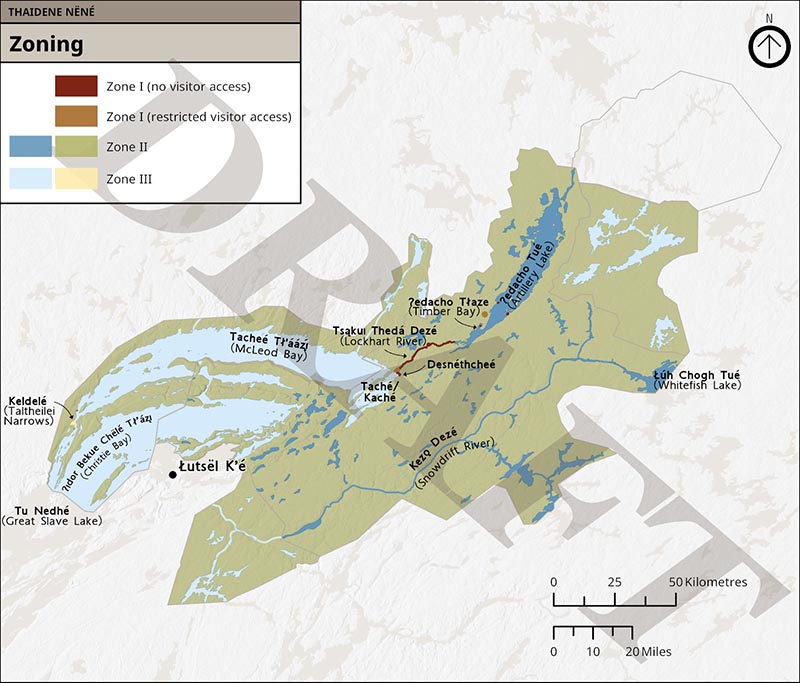
Map 1 – Overview of Thaidene Nëné Zoning — Text version
The overview map of Thaidene Nene depicts the zoning using colours. There are two colors for zone I: red for no visitor access and orange for restricted visitor access. There are two colors for zone II: dark blue for water-based areas and green for the land-based areas. There are two colors for zone III: light blue for water-based areas and yellow for land-based. The same legend is used for all the maps. A red line for Zone I special preservation with no visitor access stretches along Tsakui Theda Dezé (the Lockheart River), with small areas depicted in orange for Zone I Special preservation with restricted visitor access in Charlton Bay and Ɂedacho Túe (Artillery Lake). The waters in Tu Nedhé (Great Slave Lake) are shown in light blue to indicate Zone III.
Map 2: Zone I Desnéthcheé, Dzén Kı́n, Tsá Kı́n, Island in Ɂedacho Tł’ázı̨, Taché /Kaché Village Site, Ɂedacho Tł’ázı̨ Village Site, and Tsąkuı Thedá Dezé
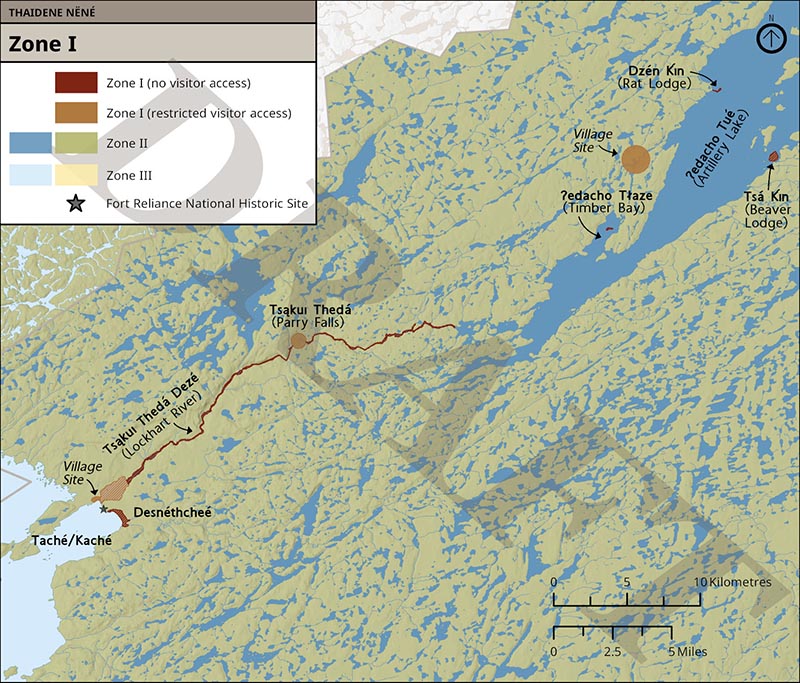
Map 2: Zone I Desnéthcheé, Dzén Kı́n, Tsá Kı́n, Island in Ɂedacho Tł’ázı̨, Taché /Kaché Village Site, Ɂedacho Tł’ázı̨ Village Site, and Tsąkuı Thedá Dezé — Text version
The map indicates Zone I no visitor access in red and Zone I restricted visitor access in orange. Tsakui Theda (Parry Falls) and Tsakui Theda Dezé (Lockheart River) are indicated in red, as are two small locations on Ɂedacho Túe /Kúe (Artillery Lake). The mouth of Tsakui Theda Dezé as well as the old village site at Ɂedacho Tł’ázı̨ (Timber Bay) are shown in orange. The location of Fort Reliance National Historic Site is indicated with a star next to the village site in the vicinity of Taché/Kaché.
Map 3: Zone III Keldelé (Taltheilei Narrows) (Commercial Lease)
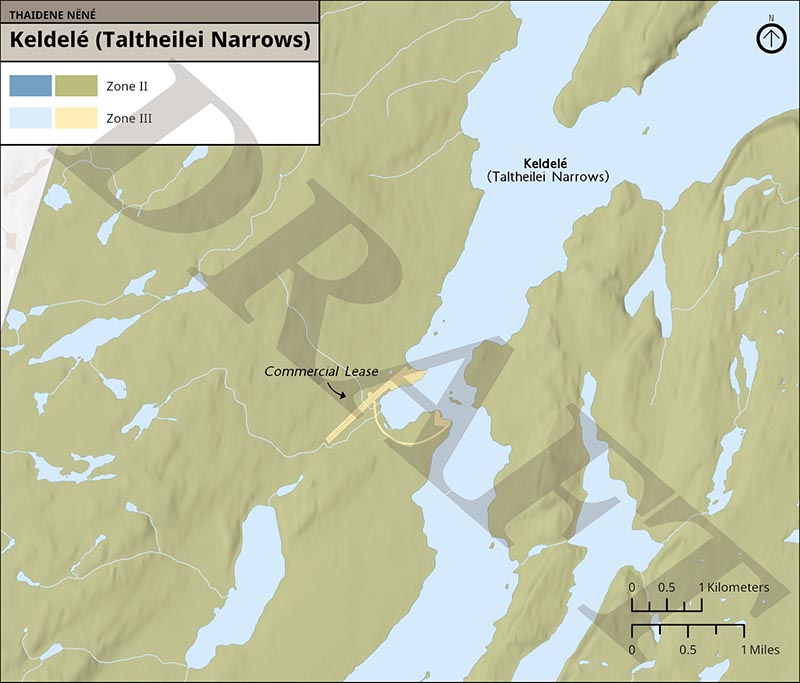
Map 3: Zone III Keldelé (Taltheilei Narrows) (Commercial Lease) — Text version
The map indicates the commercial lease at Keldelé, also known as Taltheilei Narrows, in yellow for zone III. There is no zone I in this map.
Map 4: Zone III Tthe Kálįka Tué (Stark Lake)
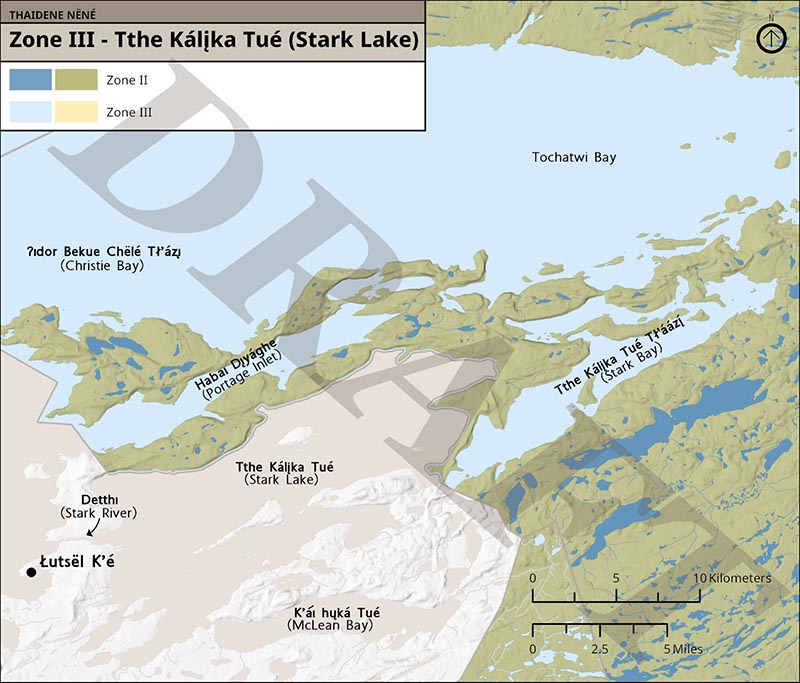
Map 4: Zone III Tthe Kálįka Tué (Stark Lake) — Text version
The map shows the narrow strip of Tthe Kálįka Tué (Stark Lake) in the national park reserve in light blue to depict that it is zone III. There is no zone I in this map.
Map 5: Zone III Ɂena Tué (Gagnon Lake) Commercial Leases
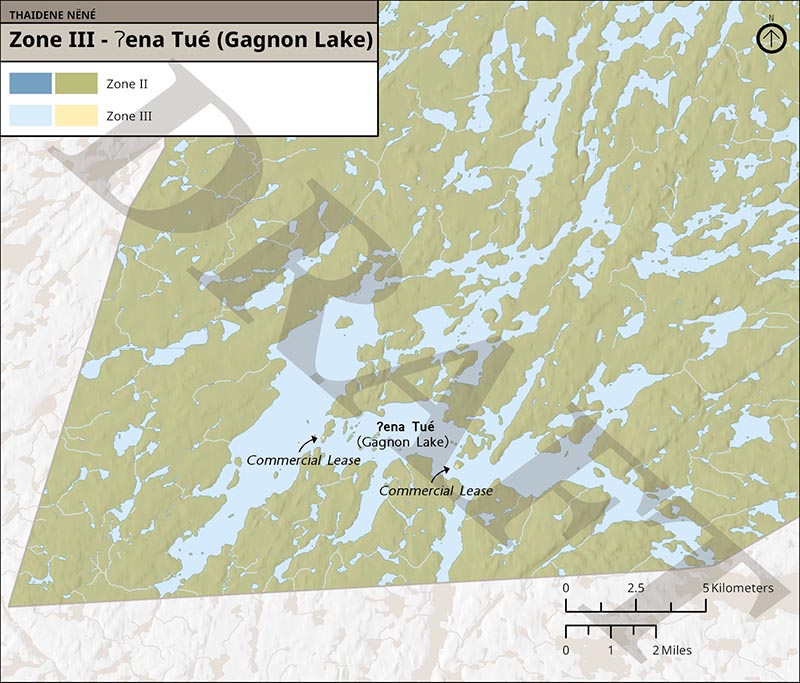
Map 5: Zone III Ɂena Tué (Gagnon Lake) Commercial Leases — Text version
The map shows the two small commercial leases on Ɂena Tué (Gagnon Lake) in yellow, zone III. There is no zone I in this map.
Map 6: Zone III Reliance Fuel Cache and Commercial Lease
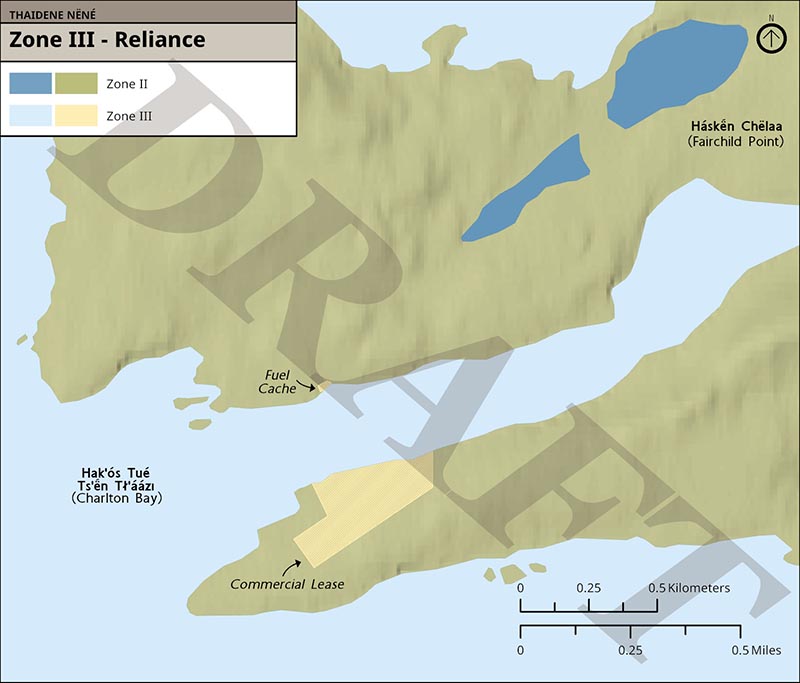
Map 6: Zone III Reliance Fuel Cache and Commercial Lease — Text version
The fuel cache and commercial lease at Reliance are shown in yellow, zone III. There is no zone I in this map.
Map 7: Zone III Tł’ąkĕle (Commercial Lease)
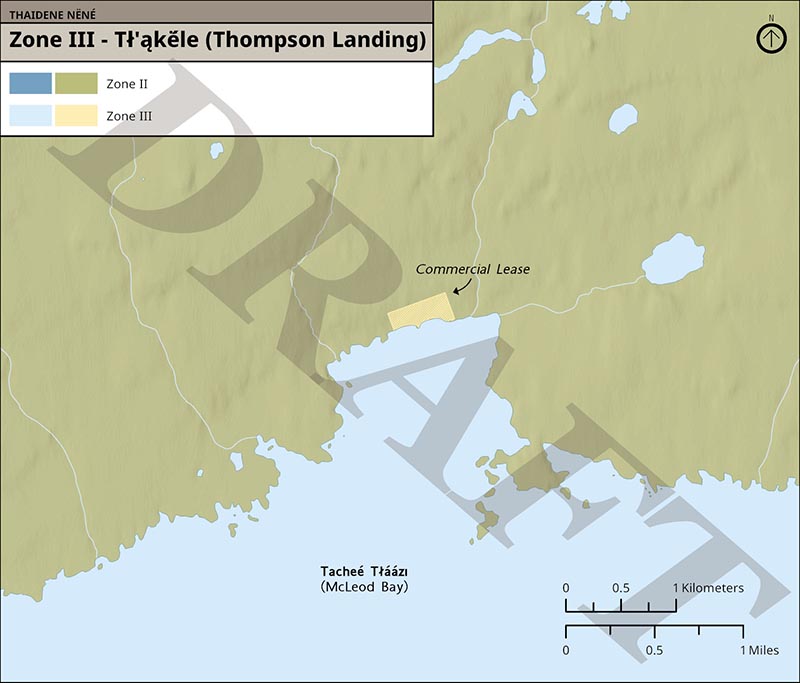
Map 7: Zone III Tł’ąkĕle (Commercial Lease) — Text version
The map shows the commercial lease at Tł’ąkĕle, Thomspon Landing on the north shore of Kaché Kuwé (McLeod Bay) in yellow for zone III. There is no zone I in this map.
Map 8: Culturally Sensitive Area - Taché/Kaché Region Draft Outline
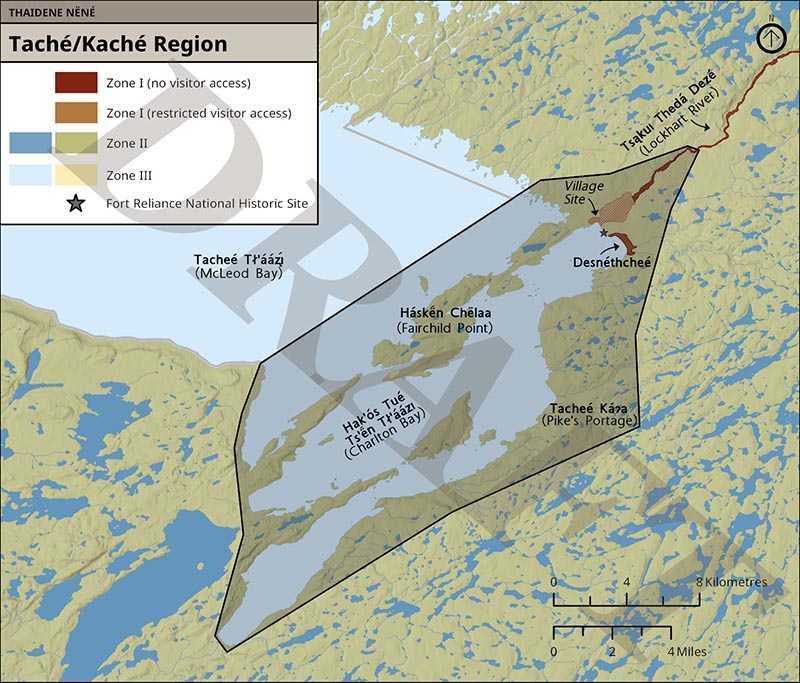
Map 8: Culturally Sensitive Area - Taché/Kaché Region Draft Outline — Text version
The map shows a shaded area indicating the approximate area of the Taché/Kaché Region. The area includes the eastern end of Kaché Kuwé (McLeod Bay), Charlton Bay, the lower stretch of Tsakui Theda Dezé (the Lockheart River) and Fort Reliance National Historic Site.
Appendix B –Strategic environmental assessment summary (Parks Canada)
All national park management plans are assessed through a strategic environmental assessment to understand the potential for cumulative effects. This understanding contributes to evidence-based decision-making that supports ecological integrity being maintained or restored over the life of the plan. Thaidene Nene National Park Reserve was established in 2019. Given this recent establishment, baseline data is currently being collected to better understand species presence in the National Park Reserve and develop ecological integrity indicators. Therefore, the strategic environmental assessment assessed the potential impacts on different aspects of the ecosystem, including species at risk that have the potential to be present in the National Park Reserve.
The plan contains several targets focused on increasing understanding of the current and historical environment of the Park Reserve, including:
- a research and monitoring program which will identify knowledge gaps and research priorities
- mapping of key wildlife habitat
- land-based Elder and youth programing in Thaidene Nëné. These programs will include sharing language, traditional knowledge, spiritual connections to the land, and Indigenous laws and stories of Thaidene Nëné
The strategic environmental assessment for Thaidene Nene National Park Reserve’s management plan considered the potential impacts of climate change, local and regional activities around the park reserve, expected increases in visitation and proposals within the management plan. The plan contains specific targets to mitigate these impacts on the environment, including:
- fire management planning which considers climate change impacts
- zoning of important sites to manage visitor access and/or behavior
- a visitor orientation program, which will include allowable uses of Thaidene Nëné and a visitor code of conduct
- a tourism strategy and harvester education to reduce negative impacts on key habitats and species
- a water resource protection strategy, which includes visitor/community education and invasive species measures
- an assessment and clean-up plan which identifies sites requiring clean-up and standards for restoration
Thaıdene Nëné Xá Dá Yáłtı led the development of Thaidene Nëné badı xá, the management plan for Thaidene Nene National Park Reserve, supported by the Partners and signatory Indigenous governments.
The strategic environmental assessment was conducted in accordance with Parks Canada policy. Individual projects undertaken to implement management plan objectives at the site will be evaluated to determine if an impact assessment is required under the Mackenzie Valley Resource Management Act, or successor legislation. The management plan supports the Federal Sustainable Development Strategy goals of Sustainably Managed Lands and Forests, Healthy Wildlife Populations, Connecting Canadians with Nature, Safe and Healthy Communities.
Many positive environmental effects are expected and there are no important negative environmental effects anticipated from implementation of Thaidene Nëné badı xá, the management plan for Thaidene Nene National Park Reserve.
- Date modified :
